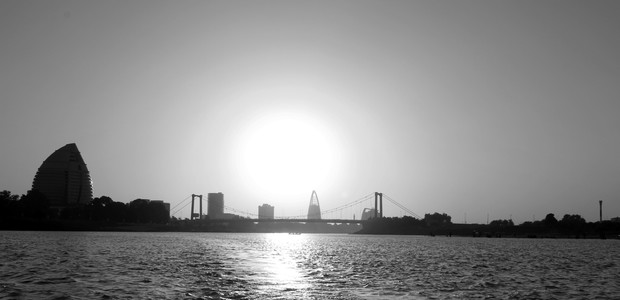Tributes to the Nile

“And the Nile is a green garb,” the late Sudanese poet Mohamed Moftahh Elfitory once extolled the Nile. The Nile for Mustafa Saeed, the protagonist of the masterpiece ‘Season of Migration to the North’ by the Sudanese novelist Tayeb Salih is the ‘Snake God’.
Elfitory and Salih were not the only writers to praise the Nile – many before and after them revelled in the river’s imagery. The Nile has been a muse for poets and artists throughout the ages.
The source of the Nile remained a mystery for thousands of years. Many stories of demons, jinns, scary valleys and grotesque creatures were common. These myths that filled ancient books painted the Nile as an extraordinary vibrating creature. Those tales and anecdotes caused the Sudanese to be infatuated with the Nile’s beauty, fresh water and mystery.
In his nostalgic poem, poet Saifeddin al-Dassouqi, describes the Nile as a life-sustaining source: “Take me back to the Nile, and never ask again about tiredness.”
The Nile is also a companion for love and the beloved when Mohamed Bashir Atiq says in his beautiful words “You, me, the Nile and the Moon, I shall not forget the night at the river banks, when we drank love out of flowered glasses”.
And about the beloved Nile, songs abound. In “يا بنت النيل - Oh daughter of the Nile!” the poets Bashir Abdurrahman and Mohamed Ahmad Al-Sheikh equate the Nile to their beloved, for she is only referred to as the daughter of the Nile. The Nile, and the daughter of the Nile hold the power, for they can wound you, as they can be the source to heal your pains.
Let’s explore the imaginations of three artists from Sudan and Egypt, reading through their relationships with the Nile, and how this mighty tender river affected their lives.
Abdelmoneim Al-Kitiabi
“Since time immemorial, the Nile has been a source of life for the surrounding communities and a teacher for earlier generations,” says poet and writer Abdelmoneim Al-Kitiabi. Al-Kitiabi is a son of Omdurman in Sudan, located east of where the Blue and the White Nile meet, to form the grand Nile. Al-Kitiabi says:
“Myths are always present since the Nile is old and a witness to the first creation of life on Earth. Poets consider it a sage, from whom they derive the wisdom of steadfastness and with him, they leave their questions about love and yearning. They feel his affection as he fertilises the soul, and inspire from him the burning love and eagerness for reunion.
The Nile has a poetic gift derived from its ancient nature. Its sacredness has passed from one generation to another through this poetic nature, reflected in the rituals and traditions of the inhabitants living on its banks. It is the source of good omen and blessings for newborns, circumcised babies and newly wedded couples. It banishes doom and gloom and soothes the suffering of widows. All these cultural denotations of the Nile’s relationship with society remain inherent and affect creativity as a silent force or an outright complainant in expressing love.
I believe the Nile teaches the meaning of strength, courage, contentment, anger, clemency and tolerance. Just as the Nile changes its mood under the influence of the changing seasons, poets too change their own moods according to the flow of the Nile. Some complain, deposit their secrets with it, or disclose its hidden secrets. This multifaceted relationship is an embodiment of the harmony of life and the path of eternal existence.
The mighty Nile holds signs that point to existential questions raised by the imaginations of people. This is why the Nile is a muse for poets. The Nile is the aesthetic factor of the existential question, and its grandeur led many to believe it is one of the rivers of Paradise: It flowed to our earth to give us strength and beauty. Hence The Nile’s beauty is inherent and sacred, its reservoir endless, from which poets can derive their wildest and deepest imagery. This inexhaustible richness can only be divine, for it is God’s magic that granted us the Nile.
Magic is the most conspicuous semantic feature which makes the Nile run free, hurdling all barriers, along with one-third of the Continent. Freedom, therefore, is one of the Nile’s indicative signs. The Nile is generous, for it reflects its beauty on earth and the whole of creation, including humans, animals, birds, plants, trees, childhood, mighty bygone civilisations, love stories and memories. All of these are merely words which qualify to awe because the Nile sheds its reflections on them.”
Musab Al-Sawi
“The Nile is not merely water flowing from the source to the estuary,” says art critic Musab Al-Sawi. Al-Sawi has spent many years of his personal and professional life documenting the creative works of artists from Sudan and abroad. For Al-Sawi, the Nile is a story about life on the banks:
“Despite the fact that the Nile is a single natural extension, life around it is diverse, shaped by the cultures, songs and sources of livelihoods of the populations who live on its banks. For example fishing in South Sudan is done with spears, while at the White Nile fishermen use nets or fishhooks.
The Nile has been and continues to be a vital source of livelihood, history and rituals. It is the natural element that inspires creative people, just like mountains and deserts. The Nile is a natural scenic view beautifully and fantastically portrayed, especially evident with the aestheticism of contrasts, from when the water floods, until when it recedes. This process leading from one pole to the other reflects an enchanting aestheticism.
Life by the Nile is interwoven with mythical stories that have long drawn features of old love celebrated through the ages, especially with the ancient Egyptians who used to offer sacrifices during drought seasons, including beautiful girls as a sign of fertility.
In Sudan, the Nile is also the confluence, it is Al-Mogran where the two Niles meet as lovers embrace. The Sudanese art leader Ahmad Mustafa says: “We want to be together where the two Niles meet at Al-Mogran.” This is a rare scene not present anywhere along the eternal Nile. This romantic portrait is only found in Sudan.
And in ancient times, a bed was made for Pharaohs in the form of a boat facing the Nile. It would be launched towards the river so that it moved through the cycles of life. Poet Amal Dongol expressed this beautifully when he said:
‘They made me believe that the bed was mine
That the boat of Ra would carry me across the River of Snakes
So as to be reborn again at dawn.’
The Nile, through its constant movement and rhythm, has inspired people imaginations of their own lives, from birth, through love, sickness and finally death.”
Nahed Saleh
The Egyptian novelist Nahed Saleh grew up near the Nile. Years later, she discovered how this initially unassuming relationship impacted her imagination and her creative work.
“I was a little girl when I listened for the first time to Umm Kulthum’s song ‘The Nile’ written by Egyptian poet Ahmed Shawqi and composed by Riad Al-Sunbati:
‘Since which era have you been flowing into villages?
Have you descended from heaven, or burst out from Paradise
in twinkling running streams?’
The poem follows the flowing routes of the Nile through countries, towns and forests from its sources in Africa until it reaches Egypt. The poem overflows with so many connotations at the level of word and tune. I was too young to appreciate the meanings and the enchanting ‘Al-Hijaz’ musical key used in the song.
I, however, felt at that moment that my heart was emotionally moved towards a geography I did not know and a history I was not aware of. That feeling recurred every time I listened to similar songs and I felt magnetically drawn to a river no one convinced me to love. It was akin to a pulse resonating in my blood and a main nerve in my emotions.
Perhaps these songs coupled with my early childhood life at the banks of a ‘tur’a’ (channel) in a village that is the product of the Nile’s geography and history, were the hidden motives behind writing my story ‘Mohamed Munir: An Egyptian Anecdote.’ It was an exceptional life in Nubia, washed by the sun and blown by the wind from four corners. Everything there fulfils its duty as dictated by nature and imagination.
All ears in our country have long been attuned to the charming voice of Umm Kulthum, and so have mine. I used to listen to her songs every day at 5 o’clock in the evening. My mother used to invite my sisters and sometimes my cousins to have tea and eat cake or corn pie at this quiet place at the banks of the tur’a, running in front of our rustic house at our small village in the Nile Delta. Most of the houses of there are symmetrically similar in their poor shapes.
It was never like the tourist picture portrayed in the movie Zainab by the leading film director Mohamed Karim, or the famous song of Mohammed Abdel Wahab, which was composed by Bayram al-Tunisi, that goes:
‘How beautiful a peasant’s life is;
he is ever care-free and comfortable;
he lies on the grass with the blue canopy of the sky above.’
This picture does not reflect peasant’s real conditions of suffering, neglect and hardships. However, the two pictures – namely, the imaginative one portrayed in the movies and songs and the one experienced on the ground, could not remove the splendid image of the Nile and our tur’a from our hearts.
The Nile is the pivot of many movies like ‘Son of the Nile’, ‘People and the Nile’, and ‘The Earth’ by Youssef Chahine; ‘Struggle on the Nile’ by Atef Salim; ‘A Taste of Fear’ and ‘Name Caller’ by Hussein Kamal’ and ‘Bride of the Nile’ by Fatin Abdel Wahab.
Each of these movies portrays the Nile in a mode that suits the story, let alone its presence as a passing or essential character in hundreds of other movies. As the myths were circulated about people’s loyalty to the Nile and the stories of the Nile bride as a symbol and sacrificial offering, the Nile remains the father, the master and the light by which guidance people live, learn, sow and reap. It creates a distinctive rhythm for Egyptians, who for them the words of Palestinian poet Mahmoud Darwish hold true when he says: “I am the son of the Nile – for me this name is enough.”
